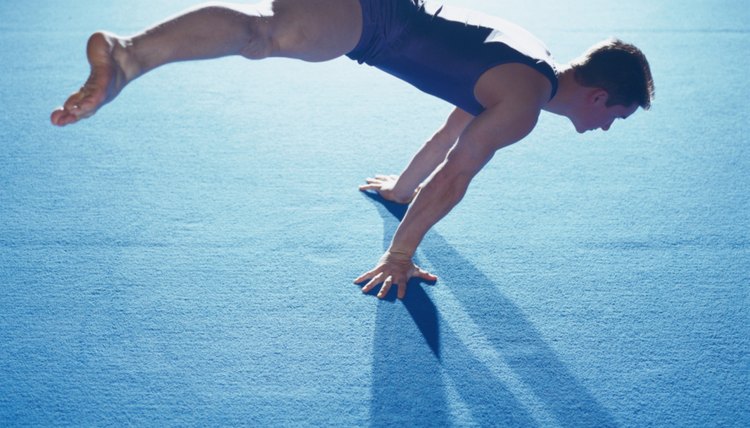The Size of an Olympic Gymnastics Floor Exercise Mat

The floor exercise is an Olympic gymnastics event that both men and women compete in. The competition area is set up as a large square, and gymnasts are required to execute routines that take them across the entire floor exercise mat, staying within the marked boundaries while they tumble, flip, leap, spin and dance. The Federation of International Gymnastics (FIG) is responsible for establishing the size and structural requirements of Olympic gymnastics apparatus, including the floor exercise.
Floor Measurements
The FIG is an international organization based in Switzerland, so the measurements follow the metric system. An Olympic floor exercise mat is required to be 12 meters by 12 meters, which equals 39.37 feet by 39.37 feet. The standard distance from one corner to the opposite corner is 1,697 cm or 55.68 feet. Allowances are made for competitions in case the floor exercise measurements are not precise. For the length and width, the 12 meters has a 3 cm margin of error. For the measurement from corner to corner, the floor has to be within 5 cm of the standard measurement.
Border Measurements
The 12 meters by 12 meters measurement covers the performance area. As you may have noticed when watching Olympic gymnastics competitions, there is a thick border around the floor, often marked by white athletic tape. This is called a delimitation strip, and it measures 5 cm or just under 2 inches. A gymnast is permitted to step on the delimitation strip during competition without penalty, but if she moves beyond the border, a deduction will be made. Many floor exercise platforms are raised slightly to accommodate springs and foam padding. The slope leading from the floor to the floor exercise mat must not exceed a measurement of 25 percent.
Surface
The FIG requires an Olympic floor exercise mat to have a smooth surface that protects the gymnasts from skidding, slipping or incurring rug burns. Olympic gymnasts need a floor that is even, balanced and elastic, without gaps. A gymnast should be able to move freely and the floor must not be excessively loud when athletes are tumbling, jumping or performing.
Safety Considerations
In addition to mandating specific measurements and surface considerations, the FIG also requires that safety precautions be taken. A safety zone around the floor exercise mat is necessary, where there are no other apparatus or structures that may interfere with floor exercise routines.
References
Writer Bio
Cari Oleskewicz is a writer and blogger who has contributed to online and print publications including "The Washington Post," "Italian Cooking and Living," "Sasee Magazine" and Pork and Gin. She is based in Tampa, Florida and holds a Bachelor of Arts in communications and journalism from Marist College.
